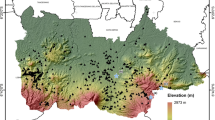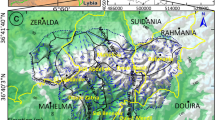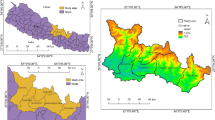Abstract
Landslides are one of the most devastating natural hazards worldwide. Landslides are triggered by different forces, such as earthquakes and typhoons, and have different characteristics in terms of distribution, influential factors, and process. The objectives of this study are to develop susceptibility maps using machine learning for two different triggering forces (earthquake and typhoon) and identify the main predisposing factors in mountainous regions of Pakistan and Taiwan. To compare different machine learning models for landslide susceptibility mapping, landslide susceptibility maps were developed using traditional (logistic regression) and modern techniques (decision tree). Results show that the spatial pattern of susceptibility map from logistic regression is continuously distributed, whereas that from the decision tree is crisp and sharp. From both models, consistent results show that the most important critical factors are completely different for both the earthquake- and typhoon-triggered landslides. For rainfall-triggered landslides in Taiwan, the most important factor of landslide susceptibility is the distance to the rivers, whereas, for earthquake-triggered landslides in Pakistan, the most important one is geological formations. Moreover, landslide susceptibility maps show that earthquake-triggered landslides tend to occur at the Muzaffarabad Formation, whereas rainstorm-induced landslides aggregate in the slope toe along the river.










Similar content being viewed by others
References
Bacha AS, Shafique M, van der Werff H (2018) Landslide inventory and susceptibility modelling using geospatial tools, in Hunza-Nagar valley, northern Pakistan. J Mountain Sci 15:1354–1370
Barbour JR, Stark CP, Lin CW, Chen H, Horng MJ, Ko CP, Yi TC, Tsai TT, Chang WS, Lee SP, Huang C (2009) Magnitude-frequency distributions of boundary shear stress along a rapidly eroding bedrock river. Geophys Res Lett. https://doi.org/10.1029/2008gl035786
Basharat M, Rohn J, Baig MS, Khan MR (2014) Spatial distribution analysis of mass movements triggered by the 2005 Kashmir earthquake in the Northeast Himalayas of Pakistan. Geomorphology 206:203–214
Basharat M, Shah HR, Hameed N (2016) Landslide susceptibility mapping using GIS and weighted overlay method: a case study from NW Himalayas, Pakistan. Arab J Geosci 9:1–19. https://doi.org/10.1007/s12517-016-2308-y
Beven KJ, Kirkby MJ (1979) A physically based, variable contributing area model of basin hydrology/Un modele a base physique de zone d’appel variable de l’hydrologie du bassin versant. Hydrol Sci J 24:43–69
Breiman L, Friedman J, Olshen R, Stone CJG (1984) Classification and regression trees. Wadsworth Int 37:237–251
Broeckx J, Vanmaercke M, Bălteanu D, Chendeş V, Sima M, Enciu P, Poesen J (2016) Linking landslide susceptibility to sediment yield at regional scale: application to Romania. Geomorphology 268:222–232
Bui DT, Pradhan B, Revhaug I, Nguyen DB, Pham HV, Bui QN (2015) A novel hybrid evidential belief function-based fuzzy logic model in spatial prediction of rainfall-induced shallow landslides in the Lang Son city area (Vietnam). Geomatics Nat Hazards Risk 6:243–271
Cevasco A, Pepe G, Brandolini P (2014) The influences of geological and land use settings on shallow landslides triggered by an intense rainfall event in a coastal terraced environment. Bull Eng Geol Environ 73(3):859–875
Chang K-T, Chiang S-H, Hsu M-L (2007) Modeling typhoon- and earthquake-induced landslides in a mountainous watershed using logistic regression. Geomorphology 89:335–347. https://doi.org/10.1016/j.geomorph.2006.12.011
Chauhan S, Sharma M, Arora MK (2010) Landslide susceptibility zonation of the Chamoli region, Garhwal Himalayas, using logistic regression model. Landslides 7:411–423. https://doi.org/10.1007/s10346-010-0202-3
Chen W, Li X, Wang Y, Chen G, Liu S (2014) Forested landslide detection using LiDAR data and the random forest algorithm: a case study of the Three Gorges, China. Remote Sens Environ 152:291–301
Chen W, Pourghasemi HR, Kornejady A, Zhang N (2017) Landslide spatial modeling: Introducing new ensembles of ANN, MaxEnt, and SVM machine learning techniques. Geoderma 305:314–327. https://doi.org/10.1016/j.geoderma.2017.06.020
Chen Y-C, Chang K-t, Chiu Y-J, Lau S-M, Lee H-Y (2013) Quantifying rainfall controls on catchment-scale landslide erosion in Taiwan. Earth Surf Proc Land 38:372–382
Chen Y-C, Chang K-T, Lee H-Y, Chiang S-H (2015) Average landslide erosion rate at the watershed scale in southern Taiwan estimated from magnitude and frequency of rainfall. Geomorphology 228:756–764. https://doi.org/10.1016/j.geomorph.2014.07.022
Chen Y-C, Chang K-T, Wang S-F, Huang J-C, Yu C-K, Tu J-Y, Chu H-J, Liu C-C (2019) Controls of preferential orientation of earthquake- and rainfall-triggered landslides in Taiwan’s orogenic mountain belt. Earth Surf Proc Land 44:1661–1674. https://doi.org/10.1002/esp.4601
Chen Y-C, Wu Y-H, Shen C-W, Chiu Y-J (2018) Dynamic Modeling of Sediment Budget in Shihmen Reservoir Watershed in Taiwan. Water 10:1808
Chen Z, Wang J (2007) Landslide hazard mapping using logistic regression model in Mackenzie Valley, Canada. Nat Hazards 42:75–89
Chigira M, Wu X, Inokuchi T, Wang G (2010) Landslides induced by the 2008 Wenchuan earthquake, Sichuan, China. Geomorphology 118:225–238. https://doi.org/10.1016/j.geomorph.2010.01.003
Chini M, Cinti F, Stramondo S (2011) Co-seismic surface effects from very high resolution panchromatic images: the case of the 2005 Kashmir (Pakistan) earthquake. Nat Haz Earth Syst Sci 11:931–943
Crosta GB, Frattini P (2008) Rainfall-induced landslides and debris flows. Hydrol Proc Int J 22(4):473–477
Dadson SJ, Hovius N, Chen H, Dade WB, Hsieh M-L, Willett SD, Hu J-C, Horng M-J, Chen M-C, Stark CP, Lague D, Lin J-C (2003) Links between erosion, runoff variability and seismicity in the Taiwan orogen. Nature 426:648–651
Dahal RK, Hasegawa S (2008) Representative rainfall thresholds for landslides in the Nepal Himalaya. Geomorphology 100:429–443
Dou J, Tien Bui D, Yunus AP, Jia K, Song X, Revhaug I, Xia H, Zhu Z (2015) Optimization of causative factors for landslide susceptibility evaluation using remote sensing and GIS data in Parts of Niigata. Japan PLoS One 10:e0133262. https://doi.org/10.1371/journal.pone.0133262
Frank F, Huggel C, McArdell BW, Vieli A (2019) Landslides and increased debris-flow activity: a systematic comparison of six catchments in Switzerland. Earth Surf Proc Landf 44(3):699–712
Gigli G, Morelli S, Fornera S, Casagli N (2014) Terrestrial laser scanner and geomechanical surveys for the rapid evaluation of rock fall susceptibility scenarios. Landslides 11:1–14
Gorum T, van Westen CJ, Korup O, van der Meijde M, Fan X, van der Meer FD (2013) Complex rupture mechanism and topography control symmetry of mass-wasting pattern, 2010 Haiti earthquake. Geomorphology 184:127–138
Huang J-C, Milliman JD, Lee T-Y, Chen Y-C, Lee J-F, Liu C-C, Lin J-C, Kao S-J (2017) Terrain attributes of earthquake- and rainstorm-induced landslides in orogenic mountain Belt. Taiwan Earth Surface Processes Landforms 42:1549–1559. https://doi.org/10.1002/esp.4112
Hussain A, Mughal N, Haq I (2004) Geological map of the Gari Habib Ullah area, district Mansehra and parts of Muzaffarabad district. AJK, Geological Map Series
Kalantar B, Pradhan B, Naghibi SA, Motevalli A, Mansor S (2017) Assessment of the effects of training data selection on the landslide susceptibility mapping: a comparison between support vector machine (SVM), logistic regression (LR) and artificial neural networks (ANN). Geomatics Nat Hazards Risk. https://doi.org/10.1080/19475705.2017.1407368
Kamp U, Growley BJ, Khattak GA, Owen LA (2008) GIS-based landslide susceptibility mapping for the 2005 Kashmir earthquake region. Geomorphology 101:631–642
Kanwal S, Atif S, Shafiq M (2016) GIS based landslide susceptibility mapping of northern areas of Pakistan, a case study of Shigar and Shyok Basins. Geomat Nat Hazards Risk. https://doi.org/10.1080/19475705.2016.1220023
Kavzoglu T, Sahin EK, Colkesen I (2015) Selecting optimal conditioning factors in shallow translational landslide susceptibility mapping using genetic algorithm. Eng Geol 192:101–112
Khattak GA, Owen LA, Kamp U, Harp EL (2010) Evolution of earthquake-triggered landslides in the Kashmir Himalaya, northern Pakistan. Geomorphology 115:102–108. https://doi.org/10.1016/j.geomorph.2009.09.035
Korup O, Schlunegger FJE, Letters PS (2009) Rock-type control on erosion-induced uplift, eastern. Swiss Alps. 278:278–285
Larsen IJ, Montgomery DR, Korup O (2010) Landslide erosion controlled by hillslope material. Nat Geosci 3:247–251
Li Y, Chen W (2020) Landslide susceptibility evaluation using hybrid integration of evidential belief function and machine learning techniques. Water 12(1):113
Liu C-C (2015) Preparing a landslide and shadow inventory map from high-spatial-resolution imagery facilitated by an expert system. J Appl Remote Sens 9:096080
Meunier P, Hovius N, Haines JA (2008) Topographic site effects and the location of earthquake induced landslides. Earth Planet Sci Lett 275:221–232. https://doi.org/10.1016/j.epsl.2008.07.020
Mirus BB, Smith JB, Baum RL (2017) Hydrologic impacts of landslide disturbances: implications for remobilization and hazard persistence. Water Resourc Res 53(10):8250–8265
Moore GC, Benbasat I (1991) Development of an instrument to measure the perceptions of adopting an information technology innovation. Inform Syst Res 2:192–222
Owen LA, Kamp U, Khattak GA, Harp EL, Keefer DK, Bauer MA (2008) Landslides triggered by the 8 October 2005 Kashmir earthquake. Geomorphology 94:1–9
Pachauri A, Pant M (1992) Landslide hazard mapping based on geological attributes. Eng Geol 32:81–100
Pareek N, Sharma ML, Arora MK (2010) Impact of seismic factors on landslide susceptibility zonation: a case study in part of Indian Himalayas. Landslides 7:191–201
Park SH, Goo JM, Jo CH (2004) Receiver operating characteristic (ROC) curve: practical review for radiologists. Korean J radiol 5(1):11
Pham BT, Bui DT, Prakash I (2017) Landslide susceptibility assessment using bagging ensemble based alternating decision trees, logistic regression and J48 decision trees methods: a comparative study. Geotech Geol Eng 35:2597–2611
Raja NB, Çiçek I, Türkoğlu N, Aydin O, Kawasaki A (2017) Landslide susceptibility mapping of the Sera River Basin using logistic regression model. Nat Hazards 85:1323–1346
Reichenbach P, Rossi M, Malamud BD, Mihir M, Guzzetti F (2018) A review of statistically-based landslide susceptibility models. Earth Sci Rev 180:60–91
Saba SB, van der Meijde M, van der Werff H (2010) Spatiotemporal landslide detection for the 2005 Kashmir earthquake region. Geomorphology 124:17–25. https://doi.org/10.1016/j.geomorph.2010.07.026
Saha AK, Gupta RP, Sarkar I, Arora MK, Csaplovics E (2005) An approach for GIS-based statistical landslide susceptibility zonation—with a case study in the Himalayas. Landslides 2:61–69
Sato HP, Hasegawa H, Fujiwara S, Tobita M, Koarai M, Une H, Iwahashi J (2007) Interpretation of landslide distribution triggered by the 2005 Northern Pakistan earthquake using SPOT 5 imagery. Landslides 4:113–122
Shafique M, van der Meijde M, Khan MA (2016) A review of the 2005 Kashmir earthquake-induced landslides; from a remote sensing prospective. J Asian Earth Sci 118:68–80
Soofastaei A, Aminossadati SM, Arefi MM, Kizil MS (2016) Development of a multi-layer perceptron artificial neural network model to determine haul trucks energy consumption. Int J Min Sci Technol 26:285–293
Tang C, Van Westen CJ, Tanyas H, Jetten VG (2016) Analysing post-earthquake landslide activity using multi-temporal landslide inventories near the epicentral area of the 2008 Wenchuan earthquake. Nat Hazards Earth Syst Sci 16:2641–2655. https://doi.org/10.5194/nhess-16-2641-2016
Wei L-W, Huang C-M, Chen H, Lee C-T, Chi C-C, Chiu C-L (2018) Adopting the I 3-R 24 rainfall index and landslide susceptibility for the establishment of an early warning model for rainfall-induced shallow landslides. Nat Hazards Earth Syst Sci 18:8
Weissel JK, Stark CP (2001) Landslides triggered by the 1999 Mw7. 6 Chi Chi earthquake in Taiwan and their relationship to topography. In: IGARSS 2001 Scanning the Present and Resolving the Future Proceedings IEEE 2001 International Geoscience and Remote Sensing Symposium (Cat No 01CH37217). IEEE. pp 759–761
Willett SD, Fisher D, Fuller C, En-Chao Y, Chia-Yu L (2003) Erosion rates and orogenic-wedge kinematics in Taiwan inferred from fission-track thermochronometry. Geology 31:945–948
World Meteorological Organization (WMO) (2007) Statements of the Status of Global Climate, Geneva, Switzerland
Wu Z, Wu Y, Yang Y, Chen F, Zhang N, Ke Y, Li W (2017) A comparative study on the landslide susceptibility mapping using logistic regression and statistical index models. Arab J Geosci. https://doi.org/10.1007/s12517-017-2961-9
Xu C, Ma S, Tan Z, Xie C, Toda S, Huang X (2018) Landslides triggered by the 2016 Mj 7.3 Kumamoto, Japan, earthquake. Landslides 15:551–564. https://doi.org/10.1007/s10346-017-0929-1
Yang W, Qi W, Wang M, Zhang J, Zhang Y (2017) Spatial and temporal analyses of post-seismic landslide changes near the epicentre of the Wenchuan earthquake. Geomorphology 276:8–15. https://doi.org/10.1016/j.geomorph.2016.10.010
Yilmaz I (2010) Comparison of landslide susceptibility mapping methodologies for Koyulhisar, Turkey: conditional probability, logistic regression, artificial neural networks, and support vector machine. Environ Earth Sci 61:821–836
Zhao Y, Xu M, Guo J, Zhang Q, Zhao HM, Kang XB, Xia Q (2015) Accumulation characteristics, mechanism, and identification of an ancient translational landslide in China. Landslides 12:1119–1130. https://doi.org/10.1007/s10346-014-0535-4
Zhao Y (2008) Zhang YJAiSR. Comparison of decision tree methods for finding active objects 41:1955–1959
Zhou C, Yin K, Cao Y, Ahmed B, Li Y, Catani F, Pourghasemi HR (2018) Landslide susceptibility modeling applying machine learning methods: A case study from Longju in the Three Gorges Reservoir area, China. Comput Geosci 112:23–37. https://doi.org/10.1016/j.cageo.2017.11.019
Acknowledgements
The authors would like to thank Mohammad Rohmaneo Darminto to validate the case study in Taiwan, and Dr. Muhammad Shafique (G-SAG) for providing us the validation data in Pakistan case study. We are grateful to the editors and anonymous reviewers for providing suggestions of paper improvement, and the MOST in Taiwan for financial supports.
Author information
Authors and Affiliations
Corresponding author
Ethics declarations
Conflicts of interest
The authors declare no conflict of interest.
Additional information
Publisher's Note
Springer Nature remains neutral with regard to jurisdictional claims in published maps and institutional affiliations.
Appendix
Appendix
Rights and permissions
About this article
Cite this article
Ali, M.Z., Chu, HJ., Chen, YC. et al. Machine learning in earthquake- and typhoon-triggered landslide susceptibility mapping and critical factor identification. Environ Earth Sci 80, 233 (2021). https://doi.org/10.1007/s12665-021-09510-z
Received:
Accepted:
Published:
DOI: https://doi.org/10.1007/s12665-021-09510-z








